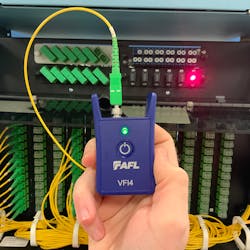AFL’s compact VFI4 Visual Fault Identifier supports reaches up to 10 km
AFL has unveiled the VFI4 Visual Fault Identifier. The instrument measures 3.1 x 1.8 x 0.8 inches yet features an output power of 5.0 mW for a 10-km range. It can be used as a troubleshooting tool for by fiber installation and maintenance technicians on both single-mode and multimode fiber.
The VFI4 uses an eye-safe Class 3R laser whose red laser light leaks from sharp bends and breaks in jacketed or bare fibers as well as poorly mated connectors. This leakage enables technicians to quickly spot faults for continuity checks, fiber tracing, splice verification, and Pass/Fail validation for mechanical connectors. It comes with a pair of adapters. The 2.5-mm universal adapter accepts FC, SC, ST, and similar connectors, while the 1.25-mm universal adapter accepts LC and MU connectors.
“As with all of our tools, the VFI4 is designed for real-world field testing,” explained Arun Jain, director of product marketing for AFL. “The VFI4 is small enough to fit on a keychain, yet has enough power to reach up to 10 km. It’s a must-have tool for any technician working on fiber optic networks.”
For related articles, visit the Test and Measurement Topic Center.
For more information on test equipment and suppliers, visit the Lightwave Buyer’s Guide.
To stay abreast of optical communications technology, subscribe to Lightwave’s Enabling Technologies Newsletter.

Stephen Hardy | Editorial Director and Associate Publisher, Lightwave
Stephen Hardy is editorial director and associate publisher of Lightwave and Broadband Technology Report, part of the Lighting & Technology Group at Endeavor Business Media. Stephen is responsible for establishing and executing editorial strategy across the both brands’ websites, email newsletters, events, and other information products. He has covered the fiber-optics space for more than 20 years, and communications and technology for more than 35 years. During his tenure, Lightwave has received awards from Folio: and the American Society of Business Press Editors (ASBPE) for editorial excellence. Prior to joining Lightwave in 1997, Stephen worked for Telecommunications magazine and the Journal of Electronic Defense.
Stephen has moderated panels at numerous events, including the Optica Executive Forum, ECOC, and SCTE Cable-Tec Expo. He also is program director for the Lightwave Innovation Reviews and the Diamond Technology Reviews.
He has written numerous articles in all aspects of optical communications and fiber-optic networks, including fiber to the home (FTTH), PON, optical components, DWDM, fiber cables, packet optical transport, optical transceivers, lasers, fiber optic testing, and more.
You can connect with Stephen on LinkedIn as well as Twitter.
